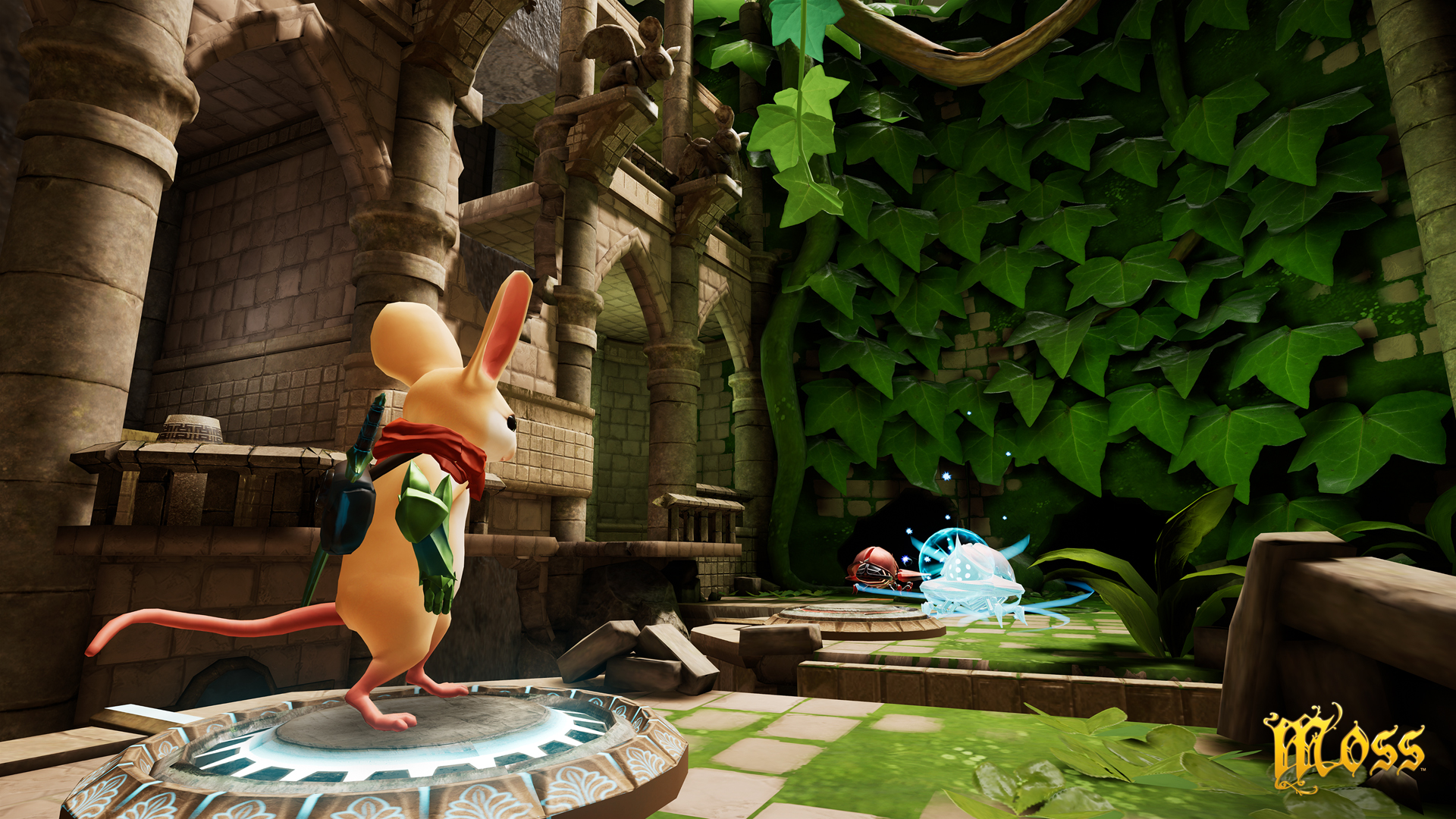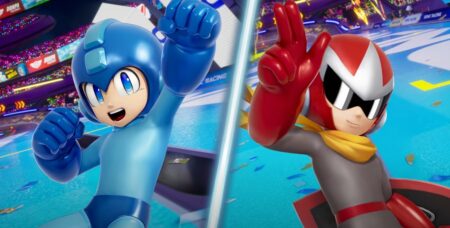Ever since its reveal trailer from E3 2017 during the Sony Conference, I had my eyes set for Polyarc Games’ Moss. The trailer was captivating and Moss made really good first impressions.
By far, Moss is one of the most anticipated PSVR games of 2018. I have to admit, we’ve had the PSVR since October of 2016, and sadly, to date, the library of games that makes it worthwhile is meager. Let’s me discuss why this game is the Moss beautiful game that I’ve played on VR.

Platform Reviewed: PSVR (on PS4 Pro)
Platforms Available: PSVR
Developer: Polyarc
Publisher: Polyarc
Release Date: February 27, 2018
MSRP: $29.99
This review is based on a review code provided by Polyarc.
The game starts off in a cathedral-looking library, where a big book is propped in front of you. There are no tutorials in this game but everything else is pretty much straightforward, almost kid-friendly (except that the PSVR is age restricted and is not for use by children under age 12) and unlike most VR games where you have a hand or hands, you instead have this blue orb, like a wisp, as your controller. The moment you start turning the pages, the narration starts. Listening to this woman’s soothing speaking voice will give you goosebumps, like a mother telling her child a bedtime story.
Fundamentally, the game introduces us to the plot’s history. Once upon a time in a kingdom far away, a fiery serpent named Sarffog and his underworld army known as the Arcane murdered the king and took over his castle in search for a powerful relic called the Glass. In retreat, Sir Argus, the commander of the king’s guards, led the mouse people to a distant clearing in the forest. With the help of the Sprites, who also sent a Glass-wielding champion of their own, he and Sir Argus sealed the clearing’s passage to keep the Arcane out. But the Sprite’s champion has fallen trying, and a tree grew on the spot where he died to keep the Sprite’s Glass safe, awaiting its next hero.
Due to the game’s cryptic choice of words for the narration, the story wasn’t really all that easy to follow. It would have been nice if we could turn back the pages of the book to go through the story again, if you’re like me, who wants to get down to the nitty-gritty of every detail presented, just like a real storybook. Sadly, this feature is not available, you can only skimp through the story by turning pages forward, not backwards.
After the narration, you enter a scene where the tree stands and enters Quill, the game’s adorable mouse protagonist who we, later on, find out is Sir Argus’ niece. She stumbles upon the Sprite’s Glass hidden beneath the tree cavity. The moment Quill touches the object she looks up to see you staring down at her. This is the part where you look down and see your own reflection in the water as a masked face or cosmic entity, something that looks like No-Face a.k.a. Kaonashi in the Japanese anime Spirited Away. From there you will be pertained to as “the Reader”, and your role will be to see to it that Quill fulfills her duty as the new champion, by assisting her in magnanimous magical ways. The main goal of the game revolves around saving Sir Argus from being captured after he departed on the journey to save Quill from her so-called “fate”, after finding out that Quill was chosen by the Sprite’s Glass to be its new bearer.

Unlike most VR games, in Moss, both first-person and third-person gameplay is involved. Using the DS Controller, you move Quill with the left and right analog stick while, as the Reader, you can grab and interact with objects in the environment. The motion controls in this game allow you to move Quill through platforming to traverse paths, pull levers, gather collectibles and attack objects or enemies. While as the Reader, you solve puzzles to clear paths and manipulate objects using the R2 trigger button. The game is not totally interactive, however.
There are intangible objects but you will know mostly which objects you can grab since they have weird markings and inscriptions on them, just like your mask. You can move objects and creatures then put them on limited angles and positions, or return them to their original state as much as the game can allow. Every gesture feels organic. And when you’re stuck in a stage, the game provides hints through visual cues or Quill points you at it.
The puzzles in-game are not totally unforgiving, it’s a good balance of easy and challenging ones. The enemies are not that difficult to defeat as well, especially that you can influence the outcome of the battles by manipulating the enemy creatures, the beetles if you don’t want Quill to do all the fighting and act god in the game. For Quill to attack, button mashing is available, and with the right timing and combination, you can make Quill do combos, although combat is rare and the game is more on puzzle-solving and platforming. The most difficult part in this game is figuring out the key to defeating enemies and the boss as quickly as possible where you have to juggle your Reader abilities and Quill’s platforming. It’s a whole new multidimensional multitasking for me.
You will appreciate the game’s sense of depth and space using the 3-Dimensionality of the VR headset to look into details: forward, backward, side-to-side, up and down. You can peek into another part of an area, or move closer to even examine Quill herself. It’s like playing with a doll-house or a diorama, and this is the best part of the game. There were a few bugs in the game (I’m not pertaining to the enemy beetles). Sometimes your controller also goes out of bounds, but that’s primarily due to the PSVR’s hardware limitations. Makes me wonder how this game can do so much more when released on a different and more dynamic VR platform.

The lighting and environmental design are simply breathtaking. The characters are excellent works of art. Playing the game on the PS4 Pro makes the colors and texture more vivid. It’s like reading a really good book, visualized and brought to life. The sound design adds to immersive qualities, I was impressed how the audio and sound effects sync up with the animations. The game however subtly lacks a good musical score.
The character development is also very good as the game also provides reinforcements. For example, if you finish a stage quickly, you get a thumbs up and a rather delightful smile (can a mouse smile?) from Quill. She even gave me a high-five once. Quill is not only adorable but an epitome of strength as well. Despite being a fragile mouse, she possesses the qualities of a heroine.
Up to this day, this is the I only game in our VR library that I can play with for several hours without getting motion sickness. My only issue here is the extremely bright transition screen from the storybook to the play area, which makes my eyes hurt every time that I had to close them. With roughly about 4 hours of gameplay, I still wanted to spend more time in this beautiful VR game because the story’s ending didn’t quite deliver, I wouldn’t say cliffhanger, but certainly, something that requires a DLC or a continuation.
Replay value is still great though since there are a dozen handful collectible scrolls to find. If you haven’t collected them all during your first playthrough, you have to look for them again by breaking barrels or pots. Some are hidden in plain sight but if you don’t look carefully or if you hurry too much in getting to the next scene, you might miss them. You just have to use your PSVR headset to look carefully around the play area.
This game’s intelligent mechanics kept me intrigued, sustained my interest to finish the game as quickly as possible. Although the experience was more of experimentation and a series of trial and errors for me (a couple of mouse-drowning deaths as well), the game still leaves me asking for more: more of the story, and more games like this in VR. My adventure with Quill in Moss was more than satisfying. It was excellent, magical, and truly a gem.







